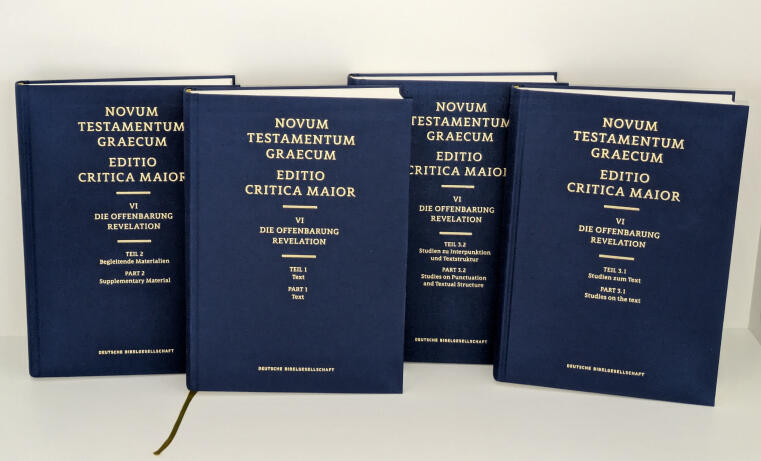Publication of four new volumes of "Editio Critica Maior"

Four new volumes have been added to the "Editio Critica Maior (ECM)" published by the INTF. The new publication includes the Revelation of John, the last book of the New Testament. The visions of the end times, also known as the Apocalypse, depict the end of the world in drastic images. They are considered to be the most cryptic text in the Bible. The interpretation of the motifs and numerical values mentioned is disputed to this day. Using software-assisted methods, the new publication comes as close as possible to the lost original text. Revelation is the only apocalyptic text in the New Testament. The new edition took twelve years to complete. A team of researchers at the Institute for Septuagint and Biblical Text Research (ISBTF) at the Protestant University Wuppertal produced the Greek textual basis for the Revelation volumes. By 2030, INTF will have produced the complete edition of the Greek New Testament. On this basis, scholars, translators and church practitioners will be able to reinterpret the controversial text.
The most significant change from the p“reviously published text is in chapter 21, verse 6. In the previous version, God declares from his throne: "It is done, I am the Alpha and the Omega". Now it reads, "I have become, I, the Alpha and the Omega". The theological difference in meaning is that either God has always been the first and the last, or he has become the first and the last. The scholars decided in favour of the latter because it is better documented in the manuscripts. In addition, the editors were able to logically understand why the first variant had been used until now: it is theologically easier to grasp. This change will have an impact on all new translations.
In the case of some textual problems which are only apparent in the original Greek, the editors were unable to make a clear decision because there was no conclusive evidence in favour of one reading or the other. For these passages, therefore, both readings have been printed on equal footing, and the reasons given in detail, so that readers can decide for themselves which variant they prefer. Other passages, however, could now be clearly confirmed as the source text, for example "666" (Revelation 13:18) as the "number of the beast/devil" and not "616" as it appears in two manuscripts.
An extensive apparatus provides an overview of the more than 100 Greek manuscripts used and a selection of the places where the Church Fathers quoted the original text. A commentary on selected variants as well as analyses of early translations and the patristic tradition complete the publication. An entire volume is devoted to the orthography of the Apocalyptic text, making it a valuable resource for classical philologists.
With the publication of the Revelation of John in the ECM, the work is far from complete. In addition to the online content, the various editions of the Greek New Testament are now being updated on this basis, such as the "Greek New Testament" of the United Bible Societies, the most widely used edition of the New Testament in the original language in the world. It is aimed primarily at Bible translators. The apparatus of the so-called "Nestle-Aland" is more accessible than the ECM. Professor Dr Holger Strutwolf, Director of INTF and one of the world’s leading scholars of the New Testament text, is also a member of both editorial boards.
An insight into the research and current work on the Greek text of the New Testament is provided by the exhibition "Critical Analysis of Sacred Texts" on the occasion of the 65th anniversary of INTF, which is on display until 29 September at the Bible Museum of the University of Münster.
The biblical scholars compared all the passages of the Apocalypse with selected manuscript sources from around the second to the seventeenth centuries. The sources differ from one another, either because of inadvertent errors in copying the texts, or because the scribes favoured a different interpretation or combined several sources. The "Coherence-Based Genealogical Method" developed at INTF makes it possible to compare thousands of text passages and thus determine their chronological interdependence, independently of the written material.

